Geology 101
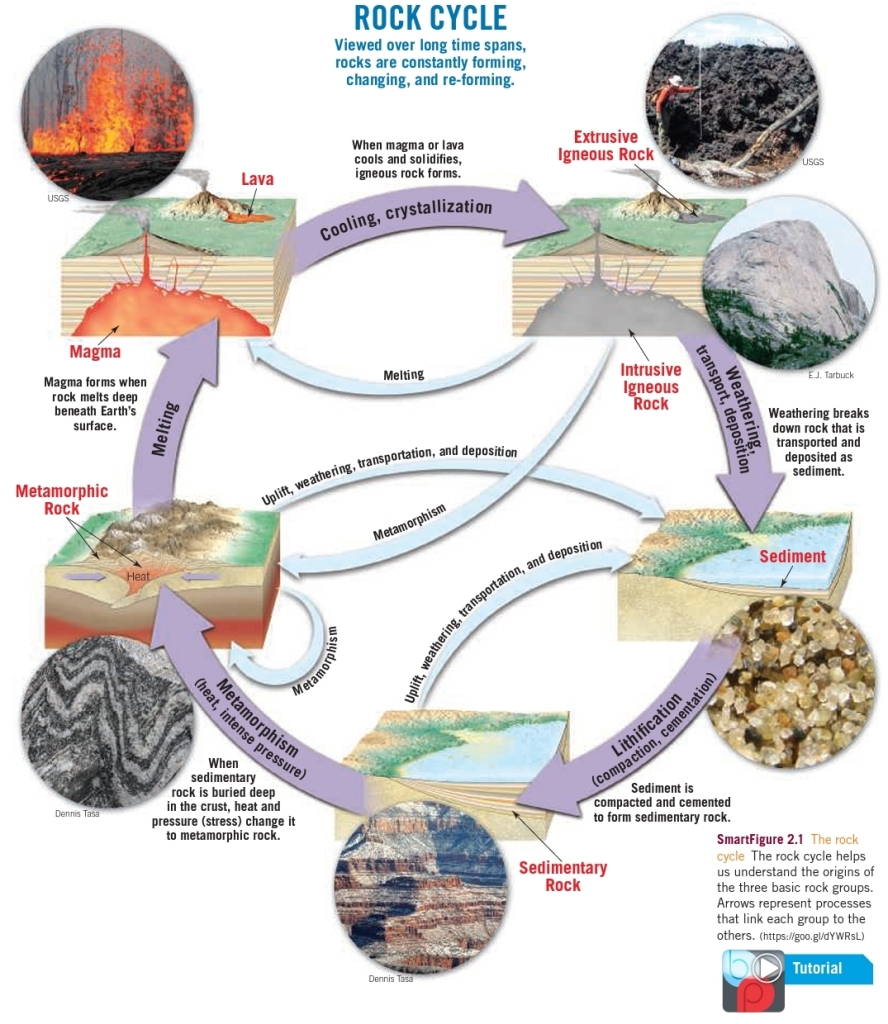
describes the interactions between the components of the Earth system
Origin of igneous, sedimentary, & metamorphic rocks & how they connected
Any rock can be transformed into any other rock type under the right conditions
The rock cycle
The rock cycle begins with magma
Forms from melting in crust & mantle
Less dense magma rises toward the surface
Erupts at surface as lava, cools within crust
Magma: generated by melting in the mantle, & some by melting the crust, & Rises because it is less dense than surrounding rock
lava: Magma reaches Earth’s surface
Cooling is crystallization or solidification
Igneous rocks are crystallized from
– Magma: within the crust
– lava: at Earth’s surface
Igneous rocks exposed at Earth’s surface undergo weathering
Atmosphere decomposes rock
Generates loose material or dissolves it
Loose material is called sediment
Transported by gravity, running water, glaciers, wind, waves, etc.
Most sediment is transported to the ocean, but some is deposited in other environments
lithification: Deposited sediment “conversion into rock” by Compaction & Cemention
Metamorphism: Deformed by great heat & pressure if deeply buried or incorporated into a mountain chain
heat can melt the rock & generate magma
Rocks aren’t stable unchanging masses over geologic time scales, & Rock cycle happens over millions or billions of years
Different stages of the rock cycle are occurring today all over Earth’s surface
– New igneous rocks are forming in Hawaii
– The Colorado Rockies are eroding & material is being carried to the Gulf of Mexico
Rocks don’t always go through the rock cycle from igneous to sedimentary to metamorphic
– Igneous remain deeply buried & become metamorphosed
– Sedimentary & metamorphic uplifted & eroded into sediment instead of melted
The rock cycle is driven by internal heat & external processes (weathering & erosion)
Processes for transform a rock
– Igneous form if molten magma crystallizes
– Sedimentary form if weathered particles are lithified (compaction & cementation)
– Metamorphic rocks form when other rocks are exposed to heat & pressure
Igneous Rocks
Formed by Fire, form when magma or lava cools & crystallizes
extrusive or volcanic rocks: Solidification of lava at Earth’s surface
– Abundant in the NW (Cascades, Columbia)
– Many oceanic islands are volcanic (Hawaii)
Most volcanic eruptions are not violent
intrusive or plutonic rocks: magma never reaches the surface, & solidifies
Exposed at the surface by uplift & erosion
– Mount Washington (New Hampshire)
– Stone Mountain (Georgia)
– Mount Rushmore & Black Hills (S-Dakota)
– Yosemite National Park (California)
Magma contains ions (Si, O) & gas (H₂O) confined by pressure, & solid crystals
Crystallization occurs as mobile ions arrange into orderly patterns during cooling
As cooling continues, more ions are added to the crystals until all of the liquid becomes a solid mass of interlocking crystals
Igneous classified by
Texture: results from cooling history, interloking texture
Mineral composition: derives from parent magma & environment of crystallization
The texture
described based on size, shape, & arrangement of grains
Used to make inferences about rock’s origin
Large crystals → slow cooling → common in magma chambers deep in the crust
Fine-grained → rapid cooling → at the surface or in small masses in the upper crust
– crystals small to see with the naked eye
vesicular voids left by gas bubbles that remained when lava solidified (scoria)
Coarse-grained →Solidified at depth while insulated by surrounding rock
– Masses of interlocking crystals roughly the same size (large to be seen by the naked eye)
Porphyritic Large crystals in matrix of smaller crystals
Different minerals crystallize under different T-P conditions & One mineral can reach large size before other minerals start to form
Glassy texture when rocks cool rapidly
Atoms freeze in place before they can arrange themselves in an orderly structure
More likely in silica-rich magmas
Form during volcanic eruptions
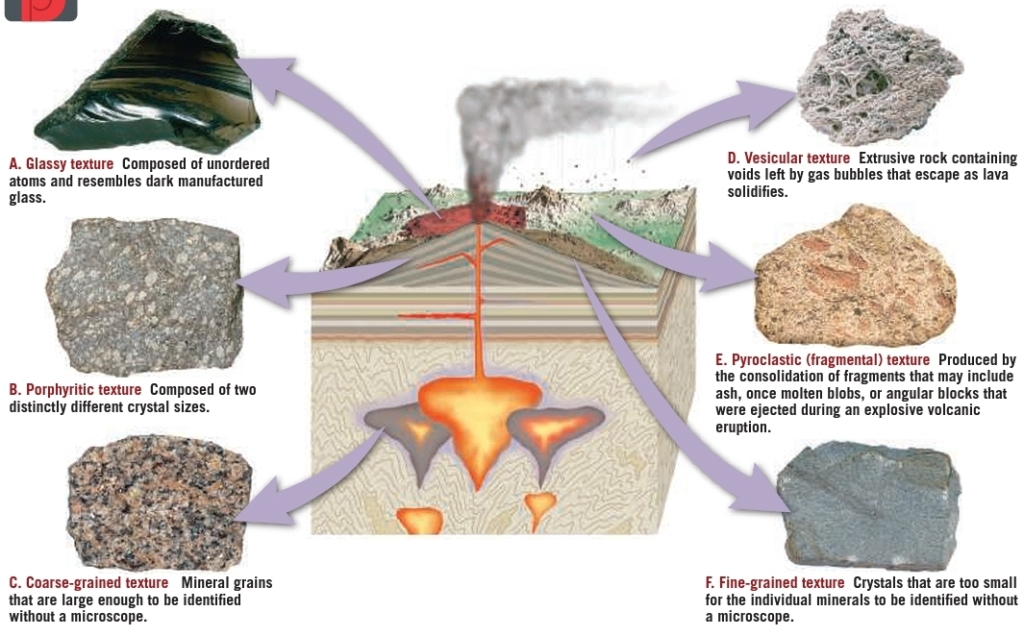
Composition
Igneous rocks mainly composed of silicate
Si & O + (Al, Ca, Na, K, Mg, Fe) make up 98% of most magmas, & includes small amounts of trace elements Ti, Mn, Au, Ag, U
During crystallization, these elements combine to form 2 major groups of silicate
Dark silicates: rich in Fe & Mg, low in Si such as Olivine, pyroxene, amphibole, biotite
Light silicates contain Na, K, Ca, richer in Si such as Quartz, mica, feldspars
Feldspars are most abundant mineral group 40% of most igneous rocks
Crystallization influenced by
Magma composition
Dissolved gas
Rate of cooling
– Slow cooling → fewer, large crystals
– Quick cooling → tiny intergrown crystals
– Instantaneous cooling → randomly distributed atoms, no crystal growth (formation of volcanic glass)
Volcanic ash: tiny shards of glass
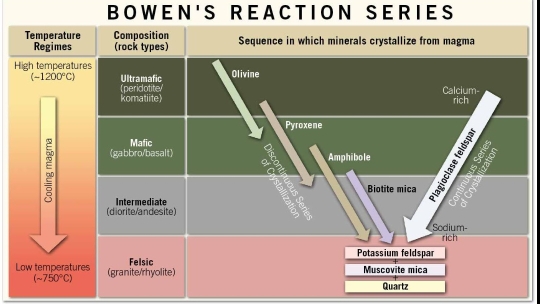
Different rock generated from the same melt
Bowen’s reaction series describes which minerals solidify at specific T
First crystallize olivine, pyroxene, plagioclase
at intermediate T: Amphibole & biotite
during late cooling: Muscovite & K-feldspar
last to solidify: Quartz
Minerals that form in the same T range tend to be associated in the same igneous rocks
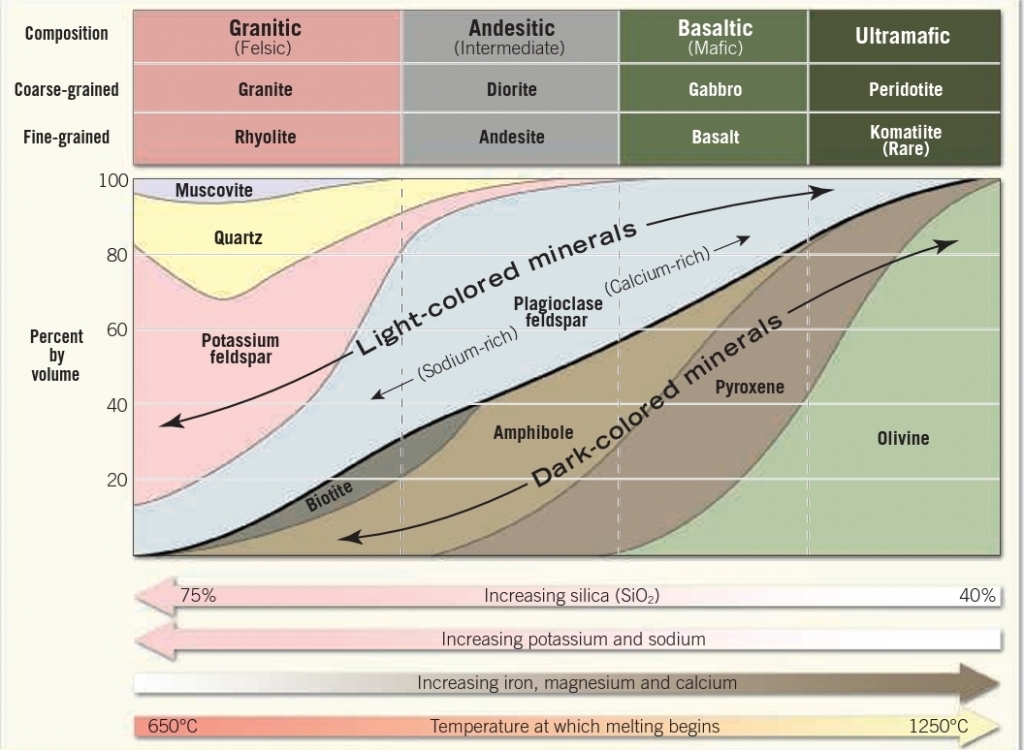
Igneous rocks of granitic composition made up almost entirely of light-colored silicates
Quartz + potassium feldspar
Felsic = feldspar + silica
Most contain 10% dark silicate minerals
Biotite mica, amphibole, 70% silica
Major constituent of continental crust
Granite: coarse-grained rock
Forms when magma solidified slowly at depth, & Uplifted during mountain building
Rhyolite: extrusive equivalent of granite
Light-colored silicates, buff, pink, or grey
Contains voids & fragments of volcanic glass
Cooled rapidly at Earth’s surface
Obsidian: natural volcanic glass
Dark in color (metallic ions) & high Si content
Chemical composition is similar to light-colored rocks
Pumice: vesicular volcanic glass
Gas escape from lava forms a frothy, gray
Many float in water because of vesicles
Basaltic (mafic) rocks
Contain substantial dark silicate minerals & Ca-rich plagioclase but no quartz
Mafic = Mg + ferrum (Fe)
Darker & denser than granitic because of Fe
Basalt: Most common extrusive rock
Dark green to black, fine-grained
Contains pyroxene, olivine, & plagioclase
Relatively common at Earth’s surface
Volcanic islands (e.g., Hawaii, Iceland)
Upper layers of the oceanic crust
Central Oregon & Washington
Gabbro: coarse-grained intrusive equivalent
Not commonly exposed at Earth’s surface
Significant component of oceanic crust
Andesitic (intermediate)
between granitic & basaltic composition
Mixture of both light & dark colored mineral
Amphibole & plagioclase feldspar
Associated with volcanic activity at continental margins
diorite: Coarse-grained intrusive equivalent
Ultramafic rocks
Contain mostly dark-colored minerals
Olivine and pyroxene
e.g., peridotite & dunite
Rare at Earth’s surface
Main constituent of upper mantle
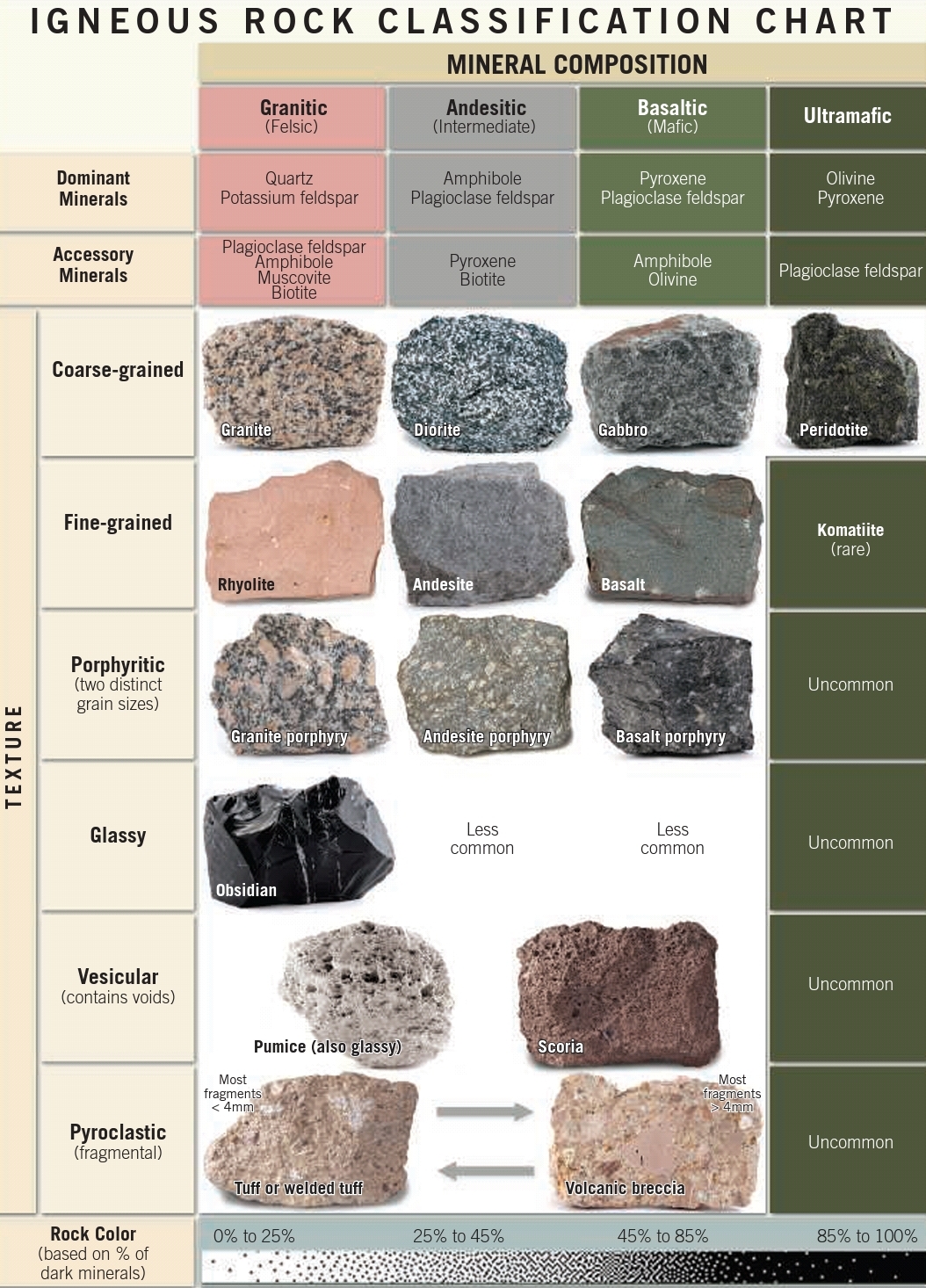
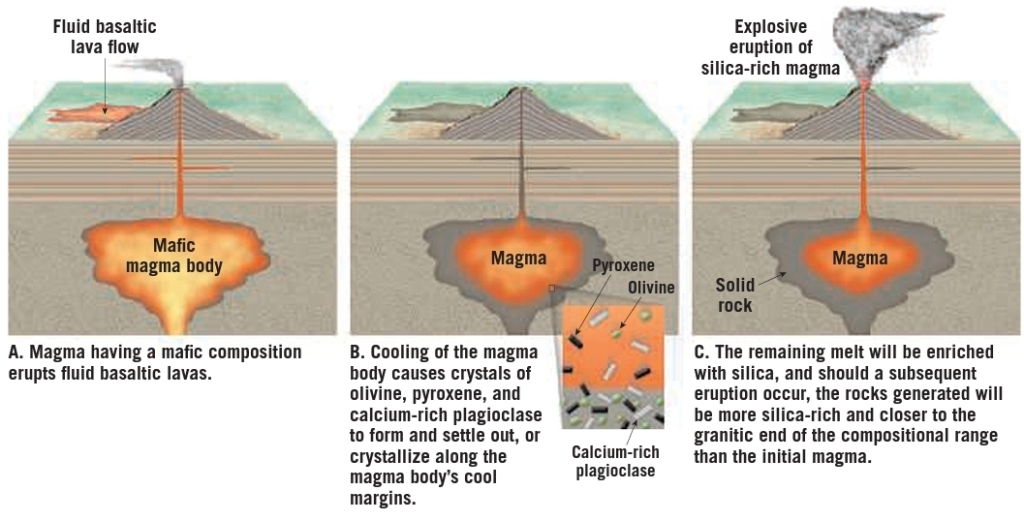
formation of one or more secondary magmas from a single parent magma
Explains diversity of igneous rocks
Magma composition continually changes during cooling
As crystals form, certain elements selectively removed, resulting in depleted magma
Crystal settling occurs when dense minerals sink to the bottom of a magma chamber
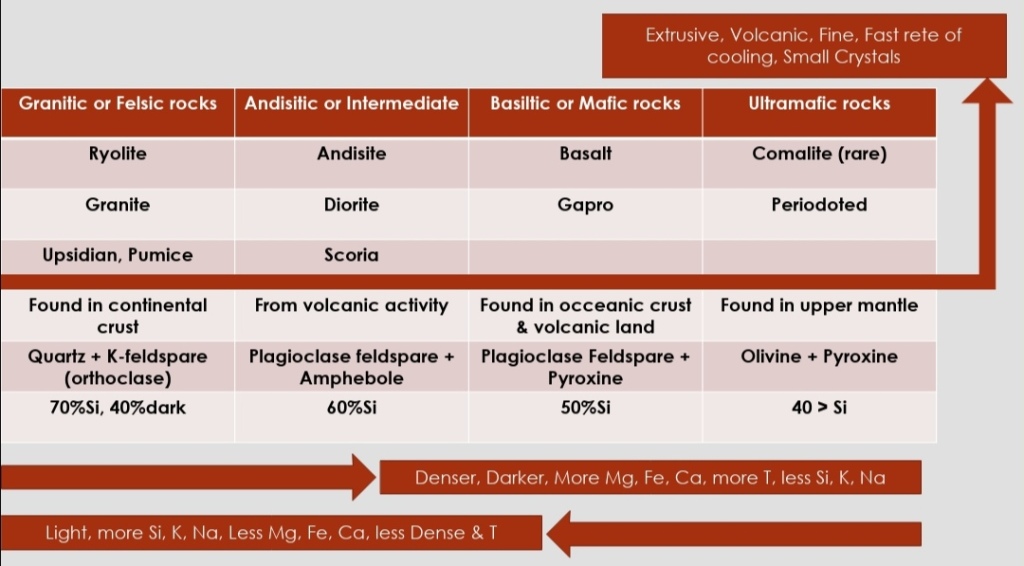
Classification of igneous rocks depend on
Crystal size: Coarse, Fine, Porphyritic, Glassy, & Vesicular
Composition: Granitic (felsic), Basaltic (mafic), Andesitic (intermediate), Ultramafic
Size of crystals related to cooling rate
Larger crystals indicate slower cooling
Smaller crystals indicate fast cooling
Sediments
Weathering & Erosion
Weathering break down of rocks, transformation of rock to reach equilibrium with environment, form Sediment
– Natural response of materials to a new environment
– Generally occur simultaneously
2 basic categories of weathering
mechanical (physical) process of breaking down rocks into smaller pieces, Each piece retains same physical properties of original material & increases surface area
chemical alters internal structure of minerals, Elements are removed or added
Ex. Mechanical Weathering
Frost wedging
Sheeting
Biological activity
How does mechanical weathering break rocks?
1. Break into smaller pieces but chemical composition does not change
2. Increases surface area for chemical weathering
How does chemical break rocks down?
1. Oxidation or dissolution by carbonic acid
2. changes mineral’s crystalline structure
Erosion transports weathered rock
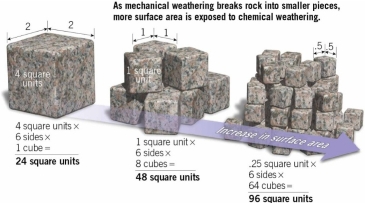
Increases surface area available for chemical weathering
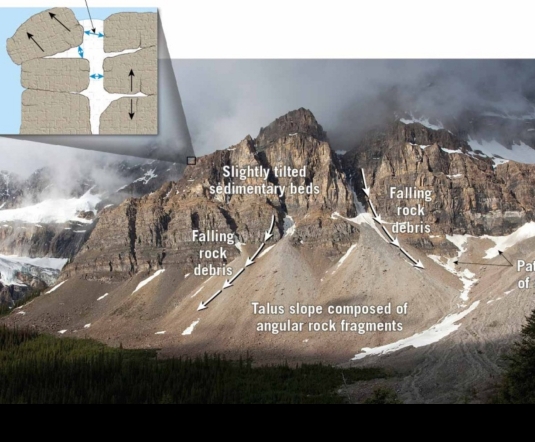
occurs when water fills cracks in rocks & expands, & Ice expands 9% when it freezes
Most pronounced in mountainous regions in middle-latitudes
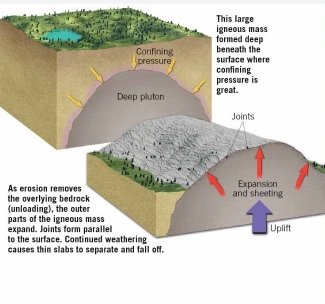
occurs when entire slabs of intrusive igneous rock break loose, Removal of overlying rock reduces pressure & outer layers expand & separate
Exfoliation Domes occure due to Continued weathering (release pressure)
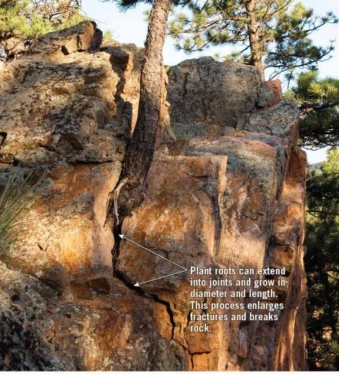
breaks rocks apart
Roots grow into cracks & wedge rock apart, & Burrowing animals expose rock to increased weathering
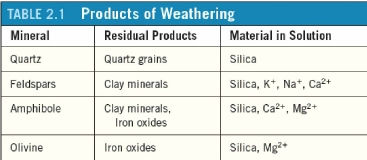
rock is transformed into new stable material
Oxidation Oxygen dissolved in water
carbonic acid CO₂ dissolved in water, & Abundant at Earth’s surface, & Interaction with minerals changes their structure
Feldspar are broken down into clay minerals
Silica is carried away by ground water
Quartz is very resistant to weathering
Sedimentary Rocks: Compacted and Cemented Sediment
form after weathering breaks rocks down, gravity & erosional agents transport & deposit the sediment, & then sediment lithified
Most sedimentary rock is deposited by solid material settling out of a fluid
Sedimentary rocks make up:
5% of Earth’s outer 10 miles g
75% of all continental rock outcrops
Used to reconstruct details about Earth’s history
Economically important: Coal, Petroleum, Gas, Metals, Fertilizer, & Construction Materials
Classification
classified in 2 groups
Detrital from weathered solid particle (rock)
Chemical from ion in solution
biochemical considered a type of chemical, Materials precipitated by organisms
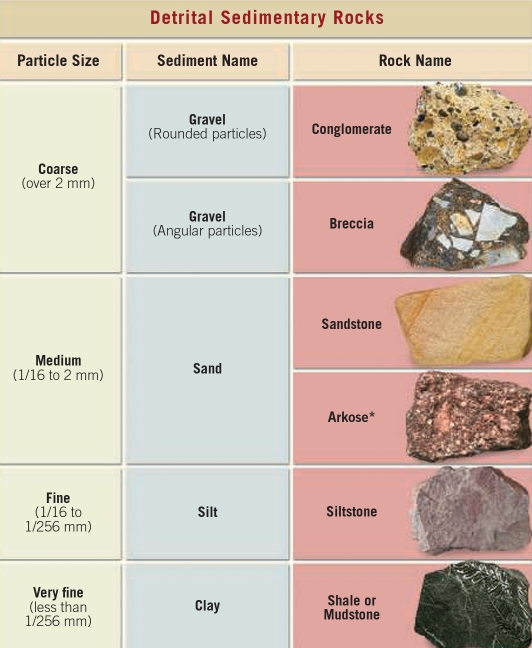
Contain variety of minerals & rock fragments
Clay & quartz are most common
classified by particle size & then composition
Used to determin environment of deposition: Higher energy → larger particles
Sandstone (or Quartz Sandsotne)
Arkosic Sandsotne high Quartz
Arkose > 25% feldspare, so has pink color
Black Shale (organic) organic materials
Red Shale has Fe-oxides
White Shale
Characteristic properties of Shale is fissile (occur in weakness zone)
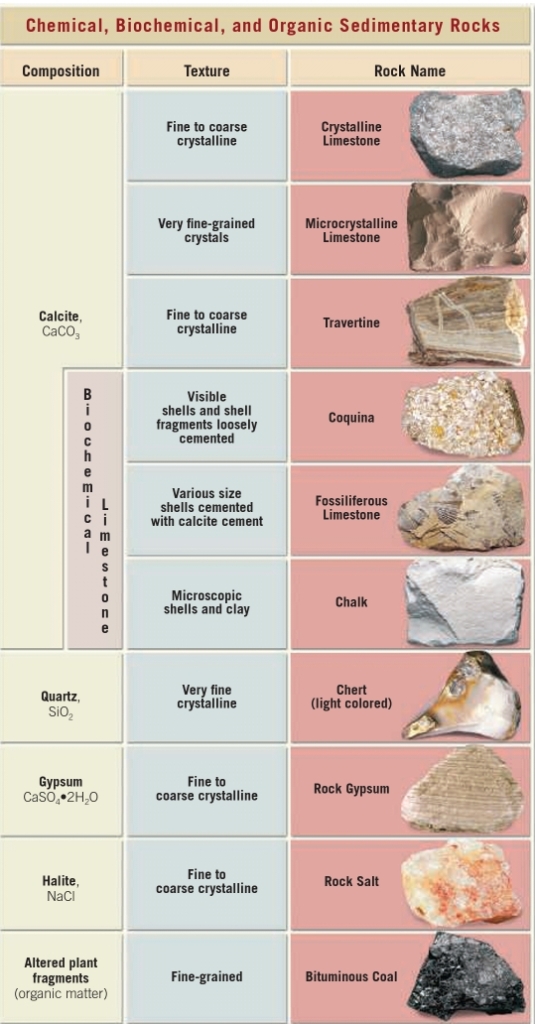
Solid material precipitates to form sediments
Ex. salt left behind when water evaporates
biochemical sediments
Eg. shells & hard parts
Limestone is composed of calcite CaCO₃, Nearly 90% is formed by organisms
Coquina: loosely cemented shell fragments
Chalk: hard parts of microscopic organisms
Travertine: inorganic limestone, in caves
Chert, jasper, agate: microcrystalline SiO₂
Salt & gypsum: in evaporite deposits
Coal consists mostly of organic matter, found in swamps
Formation of coal
Plants buried → O, H, N in organic mater volatile so its evaporating under pressure (green color)→ beat → brown leginite → Black Petuminas (high pressure & Energy) → Anthrasite (Non sedimentary)
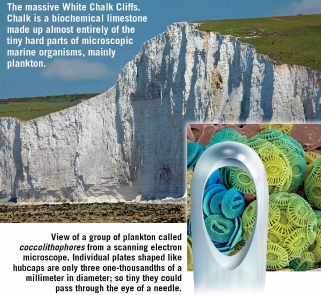
Lithification Process
process by which sediment is transformed into sedimentary rock, include:
1. Compaction occurs when grains are pressed closer together so that pore space is reduced
– Weight of accumulated sediment
– Most significant in fine-grained rocks
2. Cementation occurs when water containing dissolved minerals moves through pores
– Cement precipitates, fills pores, & joins particles together
– common cements: Calcite, Silica, & Fe-oxide
Characteristic of sedimentary rocks
Strata or Beds layers of sedimentary rocks
Thickness range [microscopic – tens m]
Mark the end of one episode of sedimentation & the beginning of another
Fossils Traces or remains of life
Important clues of ancient environment
Can be used to match up rocks of the same age found in different places
Metamorphic Rocks: New from Old
produced when preexisting parent rock is transformed
Parent rock: can be Igneous, Sedimentary, or Metamorphic rocks
Metamorphism
Elevated T & P, occurs if rock is subjected to a different environments, Equilibrium with new environment
Most metamorphism occurs in 2 settings:
1. Contact or thermal: Rock T increases because of intruding magma
2. Regional: P & T, during mountain building, produce most of metamorphic rocks
What causes metamorphism: occurs because parent rock is not in equilibrium
How does metamorphism affect rocks: Heat & pressure change texture, mineralogy, & sometimes chemical composition
Metamorphism can change the texture
Low-grade (Contact) compact, & denser
High-grade (Regional) recrystallization & growth of visible crystals
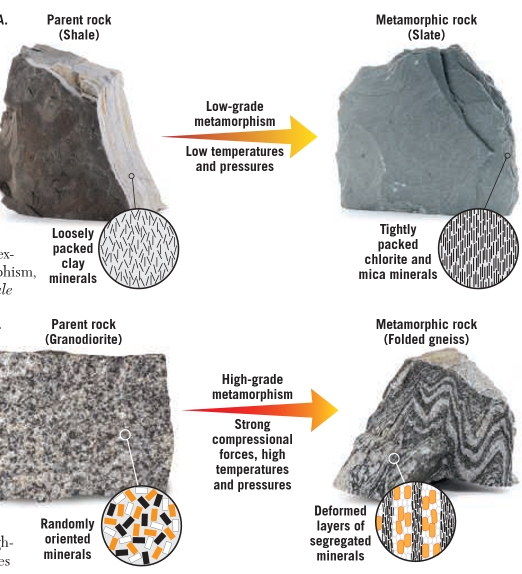
Low-grade (slight changes) to high-grade (substantial changes)
Agents of metamorphism
Heat: from intrusion of magma or burial, reactions & recrystallization of new minerals
Confining pressure (contact): equal in all directions due to burial, Compaction & recrystallization
Differential stress (regional): greater in one direction due to mountain building, Deformation & development of metamorphic textures
– Rocks can react by breaking (brittle)
– Rocks can react by bending (ductile)
– brittle Vs ductile: depending on T
Chemically active fluids: hydrothermal fluid rich in Fe, Catalyze recrystallization reactions
– Dissolve mineral from one area & precipitate it in another, & change composition of surrounding rocks
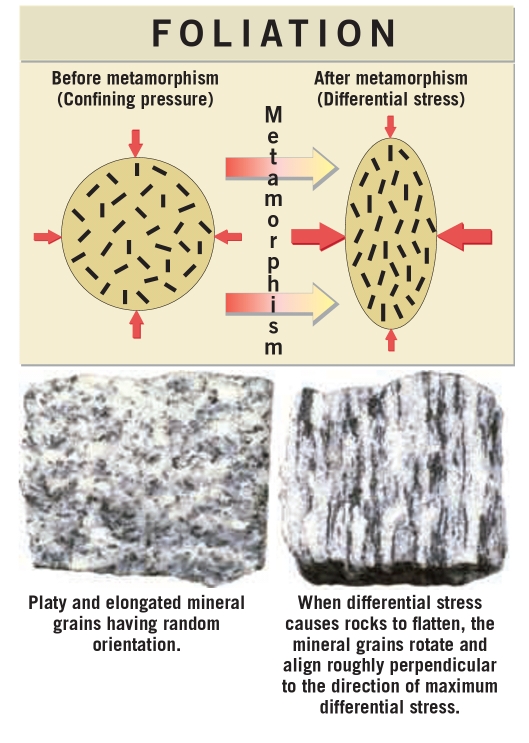
development of a flat arrangement of mineral grains
Classification
Foliation rocks (regional)
– Driven by compressional stress
– Causes grains to develop parallel alignment
– Includes:
1. Parallel alignment of micas
2. Parallel alignment of flattened pebbles
3. Separation of light & dark minerals
4. Development of rock cleavage
Nonfoliated rocks
– occur when deformation is minimal & parent rock is composed largely of stable minerals
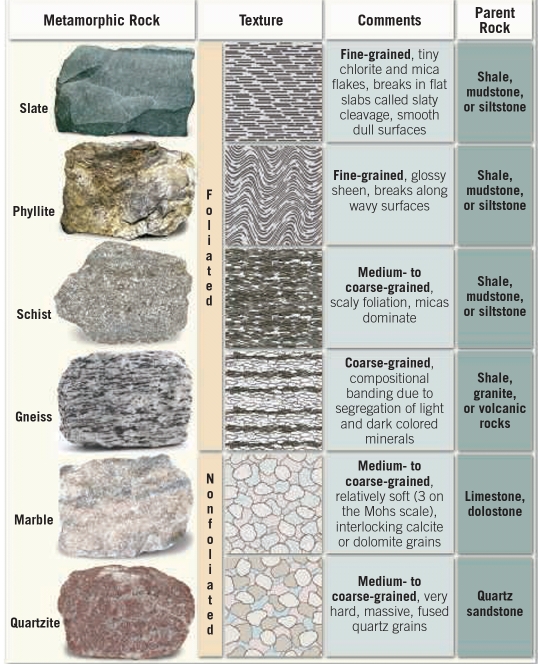
Slate has special cleavage, From shale or ash
Phyllite larger grains than slate, which give it a glossy sheen & wavy surface
Schist formed by regional mata. of shale
Gneiss banded rock that, have intricate folds
Common nonfoliated metamorphic rocks
Marble coarse crystalline, From limestone
Quartzite very hard due to quartz grains, From metamorphosed quartz sandstone
From Slate to Gneiss (grade increase)
Summary
Foliated regional, High-grade, Differential P
Nonfoliated Contact, Low-grade, Confining P
The End
